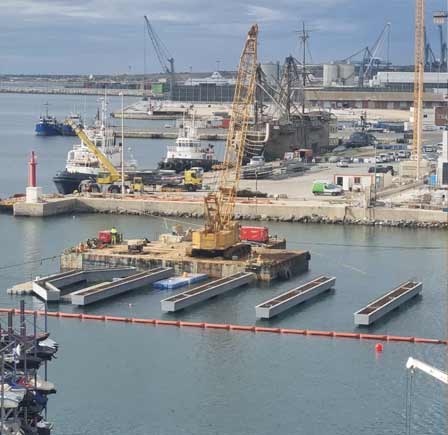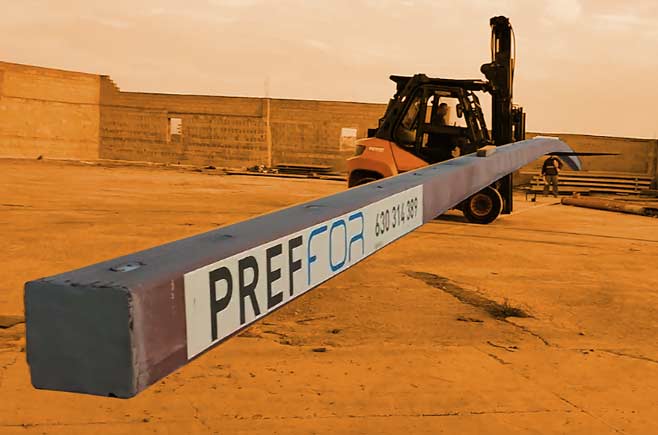We recently made a survey via Linkedin trying to figure out what the main barriers and limitations for a widespread use of UHPC (Ultra-High Performance Concrete) in the industry are. People from many different sectors, such as specialized UHPC companies (33%), the academia (22%), civil engineers (14%), precast sector (11%) or fiber producers (11%) participated. Read on to know the results and what can be done to help UHPC!
It can be said that structural Ultra-High Performance Concrete (UHPC), as we know today, is just a concrete that keeps a very low water to binder ratio with an improved packing density and that requires the use of fibers to guarantee material ductility, which is necessary for its safe use. When we put these ideas together in the right way, we enhance conventional properties of concrete, such as compressive and tensile strength, durability, cracking control, impact, fatigue, bonding strength,…
When engineers use those mechanical properties in the right way, new opportunities arise, as UHPC structures lead to a reduced self-weight of structures and slenderer; smaller amount of raw materials consumptions; fewer amount of steel reinforcement; increase of service life; minimum maintenance cost even in aggressive environments, …
Even though UHPC technology was ready to use in the late 80s, it is fair to recognize that the use of this type of concrete has been limited so far to a few specialized companies and sort of applications.
It is true that there are more and more applications in the last few years, but if this is such a good as I’m saying, why did it take so long to put this high-performance material at the service of engineering?

That was our question in the survey, in which possible answers were: (i) it is too expensive; (ii) a poor regulatory frame; (iii) engineers do not know it; (iv) lack of success cases.
As a rule of thumb, companies working with UHPC and the academia believe that it is a matter of knowledge on the part of engineers. On the other hand, civil engineers and fiber producers/experts think that is a matter of cost. A few percentage of people in all sectors consider that there is still a poor regulatory frame to deal with this material. What amount of truth is behind that survey?
Cost – Lack of suitable codes – Knowledge
Let’s share some researcher’s thoughts that are useful to have a clearer picture of the current situation and can be easily found in literature.
Following sentences respond to a personal interpretation of the literature and do not reproduce original texts. For more information about the author’s thoughts, please read references.
(UHPFRC/FRC is) ‘a character looking for a playwright able to write a proper comedy’ (1)
‘Concrete with the same strength and same vol.% of similar fibres but different fibre orientation, can differ by a factor of 2’ (2)
‘Existing standard methods did not provide any of the relevant material properties required for analysis and design (…) Fibre-reinforced concrete is sometimes poorly perceived by engineers given the lack of reliability and false expectations, which masks all the benefits of fibres.’ (3)
'There is a large spectrum of fibre reinforced concretes (FRC) (…) if there would be any conflict between design rules for different types of FRC this would lead to confusion, questions and lack of confidence by future users (…) A common basis for design with fiber concrete in general is desirable, which must be compatible with existing codes for structural concrete.’ (4)
In my 12 years of experience working with UHPC (and FRC) for the side of the engineering and the factory, I have suffered myself all those problems.
We have realized that UHPC is not a material for everything! Problem is not the cost of raw materials anymore but finding the right application in which UHPC can exhibit its great potential. We can be competitive only if we can offer an optimize design that provides an added value for the client in terms of durability, maintenance, execution time, lightness, transport, assembling or aesthetics.
Right Application – Optimise Design – Added Value
But how can an engineer do that when there is not an agreement yet on…?
• What are the right mechanical parameters for design and how to select them – Will it be possible to obtain them during the production?• How do we go from the specimens to the structure? • How do we consider the way the amount of fibers affects the residual strength? • What is the expected orientation in the structural element? Do I have to consider it in design? • Is the variability going to be high? Does it affect to the selection of characteristic values? • Strain-hardening or strain softening, is something important for design? • Do we choose straight or hooked-end fibers? Is there any difference? How do I consider it? • Fiber suppliers will give me the residual strength of the fiber o will it be the precast company? • …

Too many questions to clarify • Too many questions to agree on by scientific community • Too many different concretes and behaviors to encompass in a single code • Too many particular interests • Too many ideas to teach. Is it even taught in university?

What about manufacturers. Is it better for them? Probably it is not either. They have to face similar uncertainties during production of UHPC elements. They will have to ensure two main things: (i) pouring systems guarantee the minimum fiber orientation required in design; (ii) constitutive parameters in tension (at material level) fulfill project requirements.
(i) So far, the only way to determine fiber orientation in a manufactured element is cutting the element. Costs are higher since no indirect determination of either fiber content or distribution is available
(ii) EN-14651 provide two structural parameters (fR,1 and fR,3) that represent a structural behavior, not a material one. Variability may be quite large depending on fiber orientation. Are we measuring quality of concrete or the quality of the pouring method in a specimen instead? Are fR,1 and fR,3 the right parameters for design and to ensure quality of concrete? Could we obtain from this test some intrinsic parameter independent of fibre orientation with less variability?
Giving an answer to those questions creates a great entry barrier to both engineers and manufacturers. Don’t be surprised then for the delay in the widespread use of UHPC and FRC. We have had to give an answer on our own to all of them, so we can start designing and manufacturing cost-efficient, long-lasting, and sustainable UHPC structures. We really hope to have them in a code in a near future.
In RDC, we believe that the slowness to update, agree, and develop design codes according to the real needs of engineers and manufactures, are the key to the delay in the use of UHPC (and any other FRC) in the industry. Fibers are just a different type of reinforcement for concrete, just like steel rebars or prestressing. UHPC and FRC are just concrete, no matter how we named it. A simple, easy-understandable and reliable method to consider the whole diversity of FRCs must be found.
Young engineers are the key for the future. Making it easy for them is our way to make the efforts of more than 40 years worthwhile, as the time we move forward to a better future.
INTEGRATED AND INTUITIVE DESIGN STANDARDS – SPREAD THE KNOWLEDGE
1 Gambarova, P. (2007). Chapter 1. Introduction. In M. d. Prisco (Ed.), Fibre-Reinforced concrete for strong, durable and cost-saving structures and infrastructures. Starrylink Editrice.
2 Grünewald, S., Walraven, J.C. (2002). Sensitivity of the bnding behaviour of self-compacting fiber concrete to the method of casting. In: Procceedings of the 5th symposium on cement and concrete, Shanghai, Oct 2002.
3 Massicotte, B., Bischoff, P. (2000). Fibre Reinfroced Cocnrete. A structural perspective. Proceedings of the 5th International RILEM Symposium on Fibre-Reinforced Concretes. BEFIB 2000, 193-202
4 Walraven, J. (2009). High performance fiber reinforced concrete: progress in knowledge and design codes. Materials and Structures (2009) 42:1247-1260





